A Tale of Three Villages NCERT Solutions | Communicative English for Class 10 PDF Download
D.4. Now that you have each read one of the stories above, first complete the appropriate column of the table below. When you have done that, ask the other two students in your group about the stories you have not read. For example, ask "In which country did your story take place? What type of pollution is there?" When it is your turn to give information, only do so when the other two students ask you questions. As you receive the answer, complete the other two columns.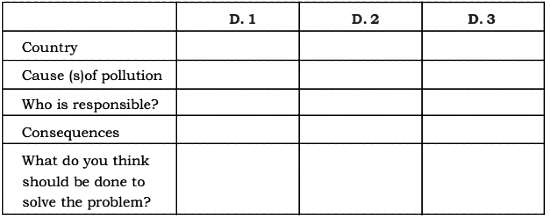
Ans: A sample of the table completed on the basis of the stories is given below. You may express your opinion wherever asked for.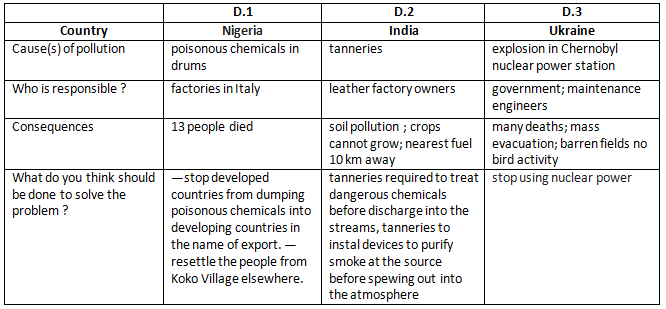
D.5. Work in groups of three, and answer the following questions :
Koko Village, Nigeria
- Why do you think there are “three large, empty metal drums” outside Mr. Nana’s front door ?
- Why do you think the drums were sent from Italy to Nigeria ?
- What do you think was in the brown paper bag that the Chief received ?
- Why are the drums referred to as “the mountain of death” ?
Ponnimanthuri Village, India
- Vijayasama and the narrator both refer many times to "they." Who do you think "they" are?
- Why do you think that the women of the village have to walk 10 km every day?
- Why does Vijayasama say: "We don't buy leather shoes or leather handbags or leather clothes?"
Vorobyov Village, Ukraine
- Why did Natasha's three children die?
- Where does Natasha live now?
- What might happen to Natasha very soon? Why?
Ans:
Koko Village, Nigeria
- Perhaps Mr. Nana brought them there, planning to use them for some domestic purposes or his children rolled them there.
- The drums were sent from Italy to Nigeria because it is easier dumping chemical in Nigeria than in Italy. Secondly, because, perhaps, the factory owners were not allowed to dump them there in Italy.
- It was money.
- They are referred to as “the mountain of death” because they are piled on top of each other very high-like a mountain. They are a sure and definite source of causing death.
Ponnimanthuri Village, India
- They are the factory owners.
- The women of the village have to walk 10 km everyday to find wood for fuel and/or get clean drinking water.
- Vijayasama says it because the villagers do not at all benefit from having the tanneries nearby. They (the villagers) are poor and cannot afford to buy leather shoes, leather handbags or leather clothes. Perhaps, they don’t need them at all seeing the poor and miserable life they lead.
Vorobyov Village, Ukraine
- Natasha’s three children died because of radiation poisoning.
- She now lives in Moscow.
- Natasha is going to die soon.
- She is poisoned by radiation.
D.6. Still working in groups of three, find any ten “happy” words and ten “unhappy” words from the passages you have just read. First, copy and complete the table below :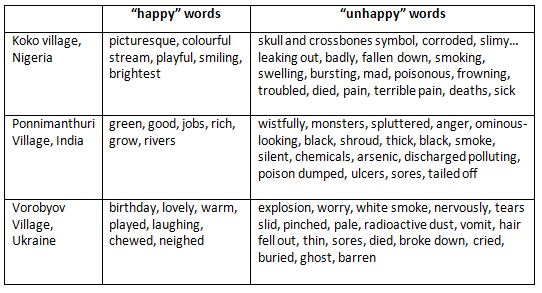 Now give reasons why you have classified them as “happy” and “unhappy” words.
Now give reasons why you have classified them as “happy” and “unhappy” words.
Ans: This activity is meant to be done at class level.
‘Happy’ and ‘unhappy’ words are mainly due to their corresponding situations. The same thing occurs here.
D.7. The Ecological Footprint The Ecological Footprint is the measure of humanity's demand on nature. It measures how much land and water area a human population requires to produce the resource it consumes and to absorb its wastes, using prevailing technology. 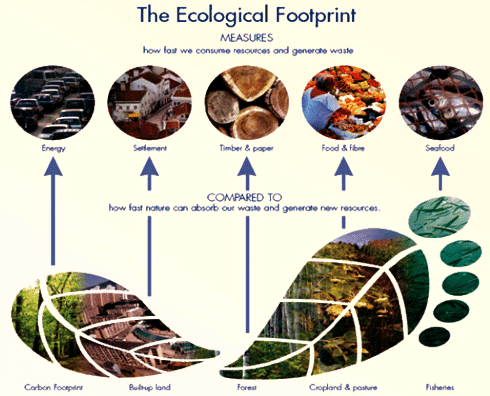 Since the 1970s, humanity has been in ecological overshoot with annual demand on resources exceeding what Earth can regenerate each year. It now takes the Earth one year and six months to regenerate what we use in a year. By measuring our Ecological Footprint we can assess our pressure on the planet. This will help us manage our ecological assets more wisely and take personal and collective action in support of a world where humanity lives within the Earth's bounds. The situation is not hopeless. There are lots of things we can do to reduce our impact on the planet! Fill in the worksheet given to measure your ecological footprint.
Since the 1970s, humanity has been in ecological overshoot with annual demand on resources exceeding what Earth can regenerate each year. It now takes the Earth one year and six months to regenerate what we use in a year. By measuring our Ecological Footprint we can assess our pressure on the planet. This will help us manage our ecological assets more wisely and take personal and collective action in support of a world where humanity lives within the Earth's bounds. The situation is not hopeless. There are lots of things we can do to reduce our impact on the planet! Fill in the worksheet given to measure your ecological footprint.
My Ecological Footprint
Worksheet : Measures Your Impact
Instructions
1. You need to write down 10 activities and record, what resources are used. Activities may cover catching a bus, brushing teeth, getting dressed, eating lunch, and playing sport, to name a few.
2. You also need to record, what resources are used to undertake the activity. The resources include water, and energy. Also record the waste produced.
3. You then need to estimate how much of the resource you have used and write down the number 1, 2 or 3 in the usage boxes. Use the following guide : For example if you only had the television on for 30 minutes the resource used would be medium. However, if you had the television on for 3 hours, it would be high. An example is given below to get you started!
For example if you only had the television on for 30 minutes the resource used would be medium. However, if you had the television on for 3 hours, it would be high. An example is given below to get you started!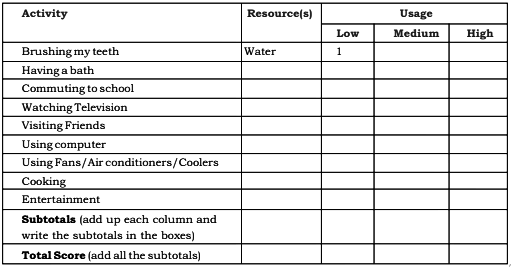 How do you rate?
How do you rate?
10-15 Friendly Flea, 16-20 Careful Kangaroo, 21-30 Dumping Dinosaur
Ans: 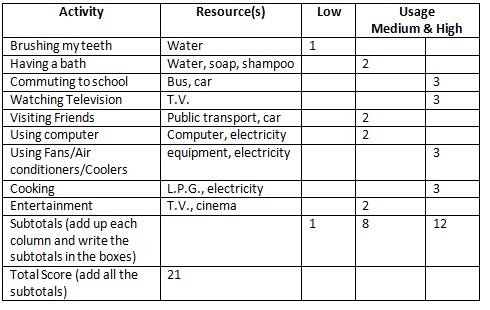 Score: 21 (beginning of the stage Dumping Dinosaur)
Score: 21 (beginning of the stage Dumping Dinosaur)
The above Table has been filled as desired. Rating is : Dumping Dinosaur Besides this, another new table in answer to question 1 under Instructions has also been given.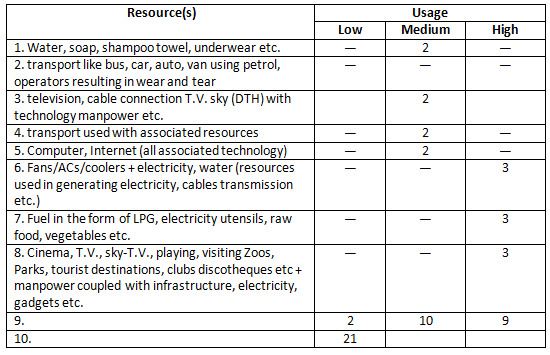 Score: 21 (beginning of the stage Dumping Dinosaur)
Score: 21 (beginning of the stage Dumping Dinosaur)
D.8. How could you improve your score?
How could you improve your score? Also reflect on the ways in which the waste produced in carrying out some of the activities above is disposed of.
My Ecological Footprint
Worksheet : How could you improve your score?
What changes could you make in your daily activities at school and at home to improve your score? Use the table belowo write down ways of using less energy, less water and making less waste.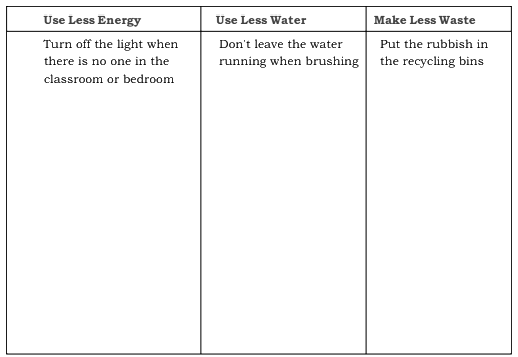 Ans:
Ans: 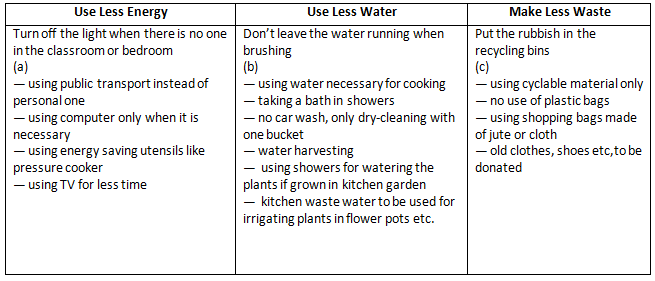
|
8 videos|250 docs|8 tests
|
FAQs on A Tale of Three Villages NCERT Solutions - Communicative English for Class 10
| 1. What is the main theme of "A Tale of Three Villages"? |  |
| 2. How does the author portray the differences between the three villages? |  |
| 3. What lessons can be learned from the experiences of the villages in the story? |  |
| 4. In what ways do the villagers respond to the challenges they face? |  |
| 5. How does the setting of each village impact its development? |  |




















